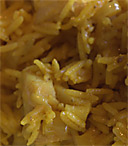
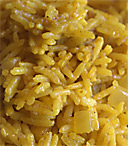


Britain's obsession with curry began with the "raj1" in India, resulting in the first known (but short lived) British curry house opening in Marylebone in 1809 to serve food to returning sevants of the East India Company who had aquired the taste. This interest was reinforced by post war immigration from the sub-continent, which turned curry into a £3 billion a year industry (2005). In the early days "a curry" was something to eat after the pubs closed (see Keith Floyds account) but things have now gladly matured and most restaurants offer good food to customers looking for more than some "grub" after the "pub". Indeed "Chicken Tikka Masala" a British curry, has overtaken fish and chips as the nations favourite meal and curry accounts for 2/3rds of all eating out.
The modern curry is often far removed from the authentic food of the sub continent, rather they are fusion cooking, we are privileged to be witnessing a food tradition in the making, be part of it!
1]British rule in India, literally "reign"
"The old men running the (film) industry just have not got a clue…Britain is no longer totally a white place where people ride horses, wear long frocks and drink tea. The national dish is no longer fish and chips, it's curry." Marianne Jean-Baptiste (British actress) May 97 (about Cannes film festival)
Curry Books
Curry In London
An incomplete A to Z of Indian & Anglo-Indian food terms in use in UK
Don't
take the recipes (where given) too literally, play around and experiment,
thats half the fun. Some, like vindaloo, I have tried to make authentic,
others like "CTM", well, what is authentic?
(Recipes
are for 2)
Balti
Curry
originally popular in Birmingham, taking its name from its pot, traditionally
eaten with bread direct from the sizzling pan.
Bhuna
Sautee
or pot roast
Biryani
Biryani
is a mild but fragrant rice dish.
Biryani
recipe
Chicken
Tikka Masala ("CTM")
Chicken
Tikka Masala is the most popular curry in the UK and is even exported back
to the sub-continent so that hungry British tourists will not be disappointed.
Basically is it chicken tikka with a cream and tomato based sauce added.
Chicken
Tikka Masala recipe
Chutney
(chatni)
Made
from spices with tamarind, unripe mango, coconut or tomato. Should be sweet
and sour but British adaptations tend to be sweeter.
Country
Captain
An
old name for a chicken curry, originating halfway through the 19th Century
and turning up in places as far apart as Liverpool and the deep south of
USA.
Dopiaza
"Two
onions". A dopiaza is made by adding half the onion early and frying it
then adding the second half raw towards the end of cooking.
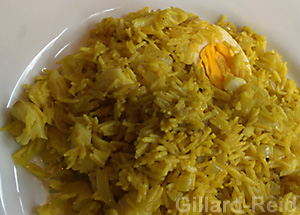 Kedgeree
(khichri)
Kedgeree
(khichri)
Kedgeree
originated in the British Raj as an adaptation of sub-continent cuisine
to meet the needs of the British.Many recipes add prawns and smoked salmon,
but I feel its best kept simple with smoked haddock or cod.
Kedgeree
recipe
Keema
Pimento
Beef
and green (bell) peppers.
The
key here is too keep the peppers quite crisp
Keema
Pimento recipe
Kofta
Minced
into meatballs.
Korma
Braised
in a sealed pot, mild and creamy.
Madras
Madras
is now known as Chennai, but you will normally still find "Madras" curries
on menus in UK. It will be at the hotter end of the spectrum, below the
restaurant "Vindaloo" and "Phall". (The Vindaloo
recipe here does not reflect this restaurant chilli grading convention
but rather the Goan dish). The "tradition" of Madras curry is that chillis
should be added in two stages. In other words adding some more chillis
to a mild sauce to make a hotter one. Perhaps try some ground chilli
at the start and then some chopped fresh red chillis near the end of the
cooking.
Mulligatawny
soup
A
corruption of "pepper water" (tamil - milagu-tannir). A curry soup invented
in the sub continent to satisfy the English need for soup.
Paneer
- (cottage cheese)
Paneer
is very easy to make at home.
Cubed
and fried paneer is good with peas or spinach as a side dish
Paneer
recipe
Rice
Everybody
has a method of cooking rice that they swear by and everyone is different.
Mine
is very simple. Buy good quality Basmati rice. Rinse it in cold water then
add one cup per 2 persons to a good quantity of boiling water. Bring back
to the boil and keep at a rolling boil for 10 minutes. Strain and rinse
with hot water. Serve. (The rinsed rice will keep warm in a cool oven if
needed). Remember that curry can be eaten with flatbreads instead of rice.
Tandoori
Cooked
in
a tandoor (clay oven)
Tarka
Seared
in hot oil or ghee,caramalised.
Tiffin
Anglo-Indian
term for lunch.
Vindaloo
This
is a Portugese/Goan, rather than Indian dish. There is some dispute about
how this dish should be prepared. I believe this is reasonably accurate
recipe and is based on "vindaloo" being deriving from wine-garlic in Portuguese
(not aloo-potato, which I believe is reverse engineering) and uses the
pork pickled in wine vinegar the Portuguese brought with them on their
ships.(This recipe has nothing to do with most restaurant vindaloos, which
are hotter versions of "Madras").
Vindaloo
recipe
Worcester
sauce
The
story goe the a barrel of indian spiced vinegar was left to ferment over
a number of years and the accidental result was Worcester(shire) sauce.
Or that Mr Lee and Mr Perrin had it made to a recipe, found it awful and
left it in a corner, later finding it had improved.
Books
Where
there is a price button ![]() you
may order the book from the bookseller.
you
may order the book from the bookseller.
 Sahni
Sahni
Classic
Indian cookery![]() hardback
hardback![]()
![]()
The
Indian comprehensive culinary classics. A brief overview and history followed
by spices and equipment, techniques, planning and then the recipes, illustrated
with line drawings with a glossary including pronounciation guide.
Classic
Indian vegetarian cookery![]() hardback
hardback![]()
![]()
"and now for something completely different"
Floyd's
India
Keith
Floyd's trip around India for channel 5. Floyds relates his journey in
his inimitable style, well illustrated with photos from the trip and of
course the recipes.
Floyd
reminisces about the early days of curry in Britain:-
".......Everybody
had probably drunk between 10 and 20 pints of beer since the first dignified
pint in the White Elephant. Two or three would have fallen by the wayside,
quite literally; some of the sensible ones would have returned to their
wives, but the single guys were hungry . A leader always emerges at a time
of crisis. It was the one who stood on the table, pint in hand, tie unknotted,
shirt undone, who, bright eyed and sweating, called out 'Who's for the
Curry 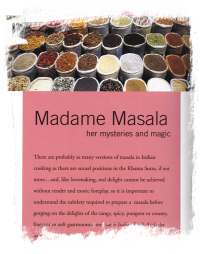 House?'
And so, once again, we piled back into the vehicles, more crowded than
before because one or two had disappeared, and headed back over the Clifton
suspension bridge, down to the city centre, past the bus station and along
to Stokes Croft where a flickering yellow neon sign announced the existence
of the Koh I Noor Indian Restaurant.
House?'
And so, once again, we piled back into the vehicles, more crowded than
before because one or two had disappeared, and headed back over the Clifton
suspension bridge, down to the city centre, past the bus station and along
to Stokes Croft where a flickering yellow neon sign announced the existence
of the Koh I Noor Indian Restaurant.
Inside
the dining room, with its 14 tables standing on a slightly sticky, thick
carpet, each table had a slightly soiled but very starched tablecloth.
The walls were covered in tawdry flock and the exhausted waiters, in their
stained dinner jackets which were almost a deep, dark green through years
of wear, adjusted their clip-on bow ties and prepared for the onslaught.
They had an air of resigned acquiescence. Each table was dressed simply
with a salt and pepper pot and a stainless steel sugar bowl filled with
white sugar lumps. The call was for - because that's all there really was
- six chicken vindaloo, nine meat Madras, four plates of evil smelling,
deep-fried, crispy Bombay duck and mango chutney and, of course, 15 pints
of lager. The bewildered waiter wrote the order on a series of little duplicate
pads and headed for the kitchen only to be called back by the blue-eyed
fly-half with crinkly blond hair, who was training to be an accountant,
and from his position of authority on the main table he would say, 'Make
that 30 pints.' Eventually, on white plates, the pungent curries and mountains
of plain boiled rice arrived. There was, of course, not enough cheap stainless
steel cutlery to go round. The Madras was hot, fiery and acrid, the vindaloo
was diabolical. One by one, chaps would go to the bog but, one by one,
they didn't return because the old hands knew that you could climb our
of the window and then you wouldn't have to pay your share of the bill.
So, every Saturday night was a mad Madras night.
Well,
dear reader, that was in another time. It was before Indian restaurants
became a culinary force to be reckoned with, before silver leaf garnished
fragrant biryanis.
It
was before Britain had ever heard of a tandoor oven..............."
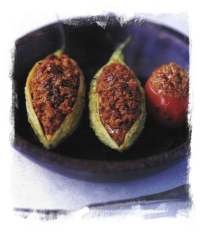 Noon
book of Indian cookery
Noon
book of Indian cookery
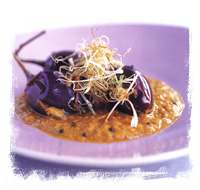 Gulam
Noon MBE founded Noon products in 1988, his company produces 3 million
indian meals a month (for Waitrose among others). Here his chefs [1] give
practical and authentic dishes for the home cooking curry enthusiast. These
recipes work well, due in part to attention being paid to which spices
should be fried and which pureed, rather than the "chuck them all in" approach
of some books. Many slightly unusual recipes are included, such as "Janglee
Maans with Sag Paneer" (Venison in spicy sauce with spinach and cheese).
Gulam
Noon MBE founded Noon products in 1988, his company produces 3 million
indian meals a month (for Waitrose among others). Here his chefs [1] give
practical and authentic dishes for the home cooking curry enthusiast. These
recipes work well, due in part to attention being paid to which spices
should be fried and which pureed, rather than the "chuck them all in" approach
of some books. Many slightly unusual recipes are included, such as "Janglee
Maans with Sag Paneer" (Venison in spicy sauce with spinach and cheese).
1]
Sumit
Malik - International Indian chef of the year 1999
B.
Sainath Rao - Taj Hotels, India, Bombay Brasserie
Puneet
Arora - Taj Hotels, Jumeirah Beach Hotel
Rakesh
Yadav - In flight kitchens, Delhi.
Ashok
Kaul - Noon products.
Vishal
Rew - Oberoi group in Bombay, Delhi and Agra
"I
have known Noon (no-one knows him as anything else) for ten years and it's
thanks to him that I once - for the only time in my life - cheated on my
dinner guests. Hidden in the kitchen were a variety of packs of his wonderful,
factory-made curries"
Delia
Smith: seeing, in the cause of research, if her guests would be fooled,
(they were).
Paperback
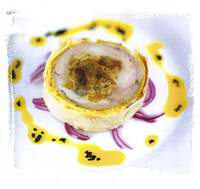 The
Cinnamon Club Cookbook - Iqbal Wahhab & Vivek Singh
The
Cinnamon Club Cookbook - Iqbal Wahhab & Vivek Singh
Curry
is established in the heart of the British high street and in the supermarket,
but one area where it has been slower to gain acceptance is in the rarefied
realms of high cuisine. The Cinnamon club set out to make a "fusion[1]"
of the styles of European restaurant cooking (especially French) with well
sourced cooking from the sub continent that for culinary purposes we can
call "India". Escoffier meets Sahni? Amuse bouche are fashioned from the
culture of Bombay street food, Belinis on the cocktail list match champagne
with lychee and rose petal. (The restaurant is housed in the premises of
the old Westminster library and so self effacing that the casal passer
by may not even realise it is a restaurant).
1] I have said Cinnamon Club food is "fusion" food but they would baulk at that description, preferring to see the food as a extension of indian styles into western forms.
The
book is divided into sections dealing with indian techniques, then basics
such as making garam masala. Starters follow, then logically main courses,
accompaniments, chutneys, desserts and then, unusual for indian cookbooks,
sections on breakfasts, cocktails and matching wine to Indian food. As
might be expected for recipes originating from a restaurant the preparation
can be quite complex and relies on supplies of things like garlic paste
and ginger paste being to hand. However, this "problem" can be overcome
by either using commercial mixes, substituting dry spices or, as I do,
reading the recipe carefully and then making up a combined paste (garlic/ginger
in the example) in advance.
Example
dishes:-
Swordfish
with mustard and honey.
Parsee
spiced stir fried squid.
Rabbit
Tikka
Green
pea and corn parcels with cauliflower and potato stir fry.
Sweet
potato cakes with ginger.
Punjabi
kidney beans.
Warm
apple lassi with champagne granita.
 The
Good Curry Guide Pat Chapman
The
Good Curry Guide Pat Chapman
Where
to find the 1000 best curry houses in Britain.
(2001)![]() (only
1999 edition listed in US)
(only
1999 edition listed in US)![]()
 The
Curry Secret
The
Curry Secret
How
to reproduce restaurant style curries.
![]()
![]()
Curry In London
Eating out in London
Traditional English food
Modern British cookbooks & reference books
Spanish cook books